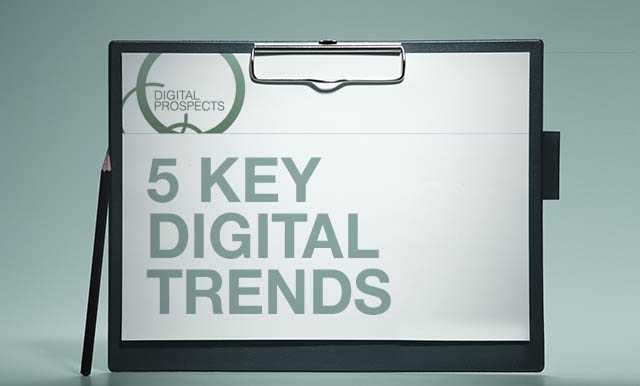
5 Key Digital Trends
This is my annual review of key trends.
We live of course in a world of continuing challenge and uncertainty but Digital remains a key engine for growth and development, for both B2C as well as B2B companies. While traditional channels of communication stagnate and fail to inspire, digital can provide a world of innovation and novelty which can capture imagination and engagement. Similarly, digital and technology-led reinvention can open up new ways of working, speed up process and time to market, awaken new partnerships and alliances to create next generation product /service propositions, streamline supply chains, deliver at lower cost and with more effective customer service levels. There’s a host of things that are now possible and “digital and data transformation” in all its forms is being cited as the 2019 No.1 agenda item for most every organisation.
1. Digital eco-systems
To set the scene:
“The ongoing digital and AI revolution is reshaping customer expectations…digital pioneers are extending the value proposition…asking what new customer opportunities exist across traditional boundaries…can we leverage partnerships and connections to find new revenues?
Greater digital collaboration between G20 companies and entrepreneurs could result in an additional $1.5 trillion in global GDP, an uplift of 2.2 percent, with the top 20 percent of companies committed to collaboration achieving higher levels of revenue growth.”
-McKinsey
“87% of large companies say that eco-systems of open and shared innovation networks will be critical to achieve higher levels of future business performance.”
-Accenture survey
“Technology is the key, and driving solo is no longer an option”
-Jeff Bezos
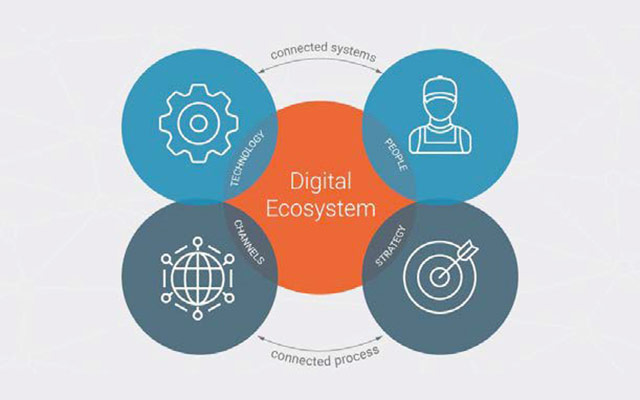
Eco-systems are being seen as a powerful new means to drive business growth and development, as a “re-imagining of industry and sector boundaries.” Here are just a few examples:
Danske Bank
Established a network of partners to create an online Utilities portal
- Aggregator of real time data feeds from realtors, utility and service providers
- Type in post code number of bedrooms in the house or square metres
- Get an estimate of running costs, local taxes, utilities etc.
- Financing advice, customer support and service
- “Become the first stop on a house search”
Home Depot
- Launched the Wink connected home network
- “Wink is the quick and simple way to connect you and your home. Manage hundreds of smart products from the best brands in one simple app”
- “Wink allows smart products from different brands (e.g. providing lighting, heating, phone, computing, TV services) to speak the same wireless language so you can easily control them via the Wink app”
- Home Depot has established partnerships with many of its suppliers to create this connected home ecosystem
Philips Healthcare
- Team up with Salesforce.com to build a future health care platform
- An ecosystem of developers building healthcare applications
- Enable collaboration and unified workflow between doctors and patients
- Partnerships with self-care providers, prevention regimes, diagnostics and treatment
- All revolving and tied into a Philips eco-world
Fiat
- Partnering with TomTom, Facebook, Reuters, TuneIn and others to create a Uconnect platform
- To provide drivers with real time news, communication, entertainment, navigation
- Looking in the future to be a one-stop portal for all driver needs from insurance to car servicing
And here’s a helpful summary from Huawei, the Chinese Networking and Telecoms multi-national, on one of their recent eco-system initiatives:
“With a view to building a digital ecosystem in the Southeast Asia region, Huawei has made a $100m million investment with the theme “Innovate for a Digital Asia-Pacific”. Over the next three years, Huawei will invest in setting up open labs, enabling cloud developers, and cultivating ICT talent in the Southeast Asian countries. Huawei’s Region President James Wu has unveiled its “developer enablement plan”, saying that it’s aimed at supporting digital economy growth and cultivating an ecosystem in the region.
“We want to create an eco-system that can empower developers and promote young talent in Southeast Asia. We have over 30 years of experience and capabilities in the ICT sector. Through APIs and development platforms, we will open up our capabilities to our partners in the region…this is a huge opportunity for developers to create targeted solutions to the digitalization of industries and grow their own business. By working together, we can dream bigger and fly higher.”
2. Digital and Data transformation
New research from Forrester has concluded that: “Businesses must double down now on their investment in technology-led transformation. Companies are finding they need to spend $4 on operational excellence for every $1 investment in digital customer experience. Now it’s all about transforming the total corporation every day to make it fit for purpose for the next decade.”
And as Adobe CEO Shantanu Narayen has crisply put it: “if we don’t reinvent then someone will reinvent us out of business”
With this great pressure to transform, what are the lessons learned among the more successful corporations, how have they driven that change, how have they galvanised the workforce to embrace new ways of working, new processes and new priorities, how get the return on that transformation investment?
Research from Forester and others has looked at many companies across a number of industries, in retail, financial services, telco and others. Companies have been examined for how and why they have failed, as much as looking at winners who have succeeded. Key organisation transformation journeys at the likes of Adobe, Barclays, Aviva, RELX, Syngenta, Sprint, Citi Group, ING Bank, UPS, Novartis, AstraZeneca and a number of others have all been investigated. The research is now highlighting the following 10 keys that can drive success. They are:
The 10 keys driving successful digital business transformation:
- An overriding vision and strategy
- CEO personal full-time involvement
- Streamlined objectives
- Inject the voice of the customer
- Emphasise /dramatise the urgency
- Agile ways of working
- Break down silos
- Town hall comms /employee engagement
- Investor management
- Link everyone’s pay and benefits
For the purposes of this short “key trends” note, let’s just consider the first item: “an overriding vision and strategy”. (there’s a fuller case note of mine available if requested).
There’s a startling example of this from a recent speech by Chinese Premier Li Keqiang:
“We will become the global leader in data and AI...supremacy in artificial intelligence (AI) is very important”. China has announced plans to draw level with the US by 2022 and to dominate global AI by 2030.
As Ed Luce of the FT has commented: “China is already ahead of its Silicon Valley counterparts in areas like online payments, e-Commerce, visual recognition, voice software, it is fast catching-up on driverless cars. Today the US is the world’s technology leader. With China’s new stated vision and investment tomorrow may look very different”.
It’s this type of vision-setting which can be so powerful, to set that transformational target and set of goals for the total organisation. Other examples include: Home Depot: to be the No. 1 omni-channel retailer in the US, or at Adobe: to transform from a traditional desktop software company to an always-on online services subscription business, or at Elsevier: to move from publishing education books to an information services software provider, or at TUI, the world’s largest holiday tour operator: to transform from an intermediary selling hotel and flights on behalf of others to now becoming the tour destination owner in our own right, or at UPS: to have the most advanced parcel tracking real time data capability of any company in the world, whether that be FedEx or Amazon, committing an ongoing annual capital investment of $1bn to sustain that, or at SAP: to become the world’s largest cloud- based software solutions vendor. All these companies have found that the setting of a transformation vision that is “challenging, inspiring and stretching but just about achievable” has been a critical catalyst to action and transformative change.
3. Customer data and analytics: the untapped potential
A few recent headlines:
“GSK (Glaxo) announce partnership with McLaren Formula 1 motor racing to access their expertise in big data analytics”
“Shop Direct unlocks the value of real-time analytics”
“IBM now have a team of 17,000 worldwide focussed on Data & Analytics”
“American Express forges new customer relationships through deep analysis and research”
“Uber, Amazon, Netflix have been pioneers in data science, machine learning and predictive analytics, they are now being joined by a host of others”
“Alexander Stojanovic, VP at eBay, describes how analytics is at the heart of their key business decision-making”
“Beth Butterwick, CEO at Karen Millen, has commented: “if we truly understand the customer data, understand the journey from beginning to end, then we have the strategic horsepower to influence the entire organisation”
Few doubt the value of analysis to drive better decision-making. In these days where there is a “deluge of available data” there is a growing imperative to find ways to capture, interrogate and find the key insights that can drive competitive advantage.
However, a recent study from the Aberdeen Group showed that a surprising 78% of company executives felt that their organisations “struggled to make effective use of customer data”. At the same time, those who were able to master customer analysis and insight showed remarkable results. They could point to increases in:
- net new customer revenues
- revenues from customer referrals
- cross-sell and upsell gains
- plus improvements in annual % customer service costs.
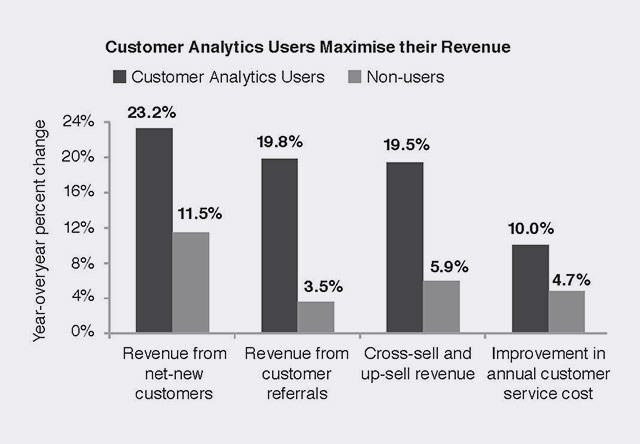
Amazon are so often cited these days as a best practice, but when I interviewed them, they spoke about the following:
“Of all the things we do today, we believe it’s our real time customer analytics that make the difference.
“We have a team monitoring customer activity by the second and we can see immediately what’s working, what’s not, we can identify price change opportunities, page lay-out changes, product-bundling and we can check this across all users and our whole customer base”.
“What really makes this data monitoring work is that we use it and make the changes in real time too. How do we do that? We have a “virtual circle” of Analytics, UX/Conversion and Web Dev. That is made up of three core groups of people who work very actively together. They are co-located, they report to one person, they are the key commercial grouping”.
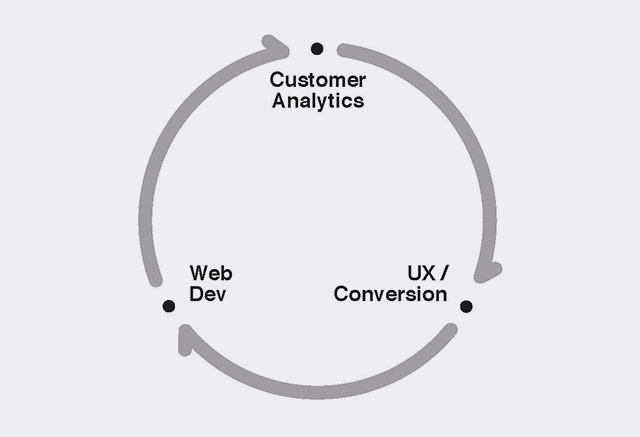
4. Influencer Marketing (and the death of paid-for advertising)
Recent research is showing something stark: a significant reduction in the power and effectiveness of “traditional” paid-for advertising. With the advent of social media and its emergence as a dominant communication medium, people can now quickly and easily see and read what peers, friends, celebrities, commentators, and key influencers have to say about a product, a movie, new music, a restaurant, holiday, travel options, a new company service a bank, an insurer…or whatever it might be. People trust the influencer more and their decision-making and choice is nowadays much more driven by that than by any piece of paid for advertising.
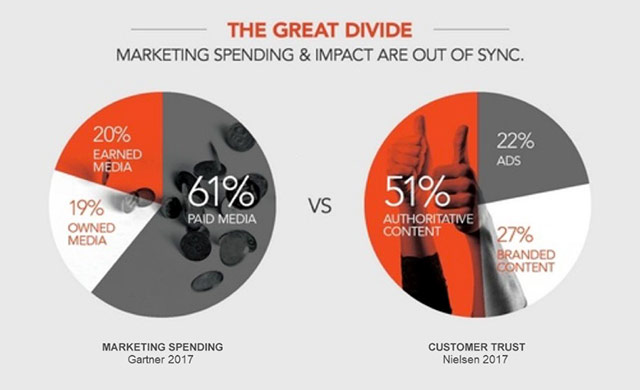
In the past 5 yrs, there have been a number of developments which have established “Influencer Marketing” over the value and efficacy of paid for advertising:
Some stats:
- 69% of consumers say that their preferred shopping channel is through social media and social networks - Accenture survey
- 74% cite peer recommendation as the key influence on their purchase decision - IDC Research
- 82% of people use recommendations from people they know to decide what to buy - Nielsen
- Influencer Marketing now generates the highest RoI of all marketing activity with up to 6x return for every $ spent - HYPR
Alongside all the positive developments around Social media and IM there have been other developments which are making display and paid for advertising less attractive:
- The number of people using ad blockers is now estimated at 200m meaning that about 20% of all the online advertising never even gets seen!
- The costs of online advertising have increased substantially over the past 5 yrs further reducing its RoI
Advertising is now dominated by the duopoly of Google and Facebook who take c.65% of all online ad-spend (with Google having the majority of that). That duopoly have led a substantial increase in advertising costs, estimated to have risen 300% in the past 5 yrs, with eg Google cost /branded click costing up to 61% more in the past 12 months (research by SearchEngineLand),
As IM becomes a more developed marketing tool, so companies are realising they don’t need to sign-up the biggest celebrity they can. It’s much more about authenticity, that’s become the latest buzz. Finding people who are brand users and already keen advocates, they are the ones who have the credibility and believability that can properly influence others’ purchasing behaviour. Such people are now also being described as “micro-influencers”, perhaps with just a small influence network themselves but who allied with a multitude of similar others can form a powerful group.
Brands also are finding that micro-influencers are easier to find, quicker to sign-up and more controllable in what they say (as opposed to some celebrity figure who might be more inclined to say something unscripted!). Also such micro-influencers cost less. Most will charge c. $100 and often significantly less per branded post. On Facebook, the average micro-influencer charge is a usually a lot less than the average $250 per branded Facebook post.
All this means that for a campaign cost of c.$5k, a brand could expect eg approximately 35 to 100 Instagram posts that could reach c. 200k followers, or around 60 to 200 Twitter posts that could reach around 300k or around 35 to 100 Facebook posts that could reach around 125k followers, or some combination thereof.
So not a substantial investment, the ability to easily trial and set-up, if unsure outsource to one of the myriad of agencies who now offer social media IM platforms and campaigns, easy to track and measure, and discovering and unleashing the potential of that wider group of people who love your product /service, want to tell people about it and happy to take a small fee to do that.
B2B companies are also increasingly seeing the power of digital to transform their customer engagement and communications. Digital marketing is on the rise and IM is becoming an important part of that sales and marketing programme.
- 56% of B2B purchasers search online to find testimonials and what others say about a company’s products - Journal of Marketing
- 79% of B2B customers say that what they see and read on social media is a key influencer on their purchasing decision - Forrester
- B2B e-Commerce sales in the US are expected to hit $1trillion in 2017 and worldwide the forecast is c. $7 trillion by 2020 accounting for more than 25% of all B2B sales - e-Marketer /Frost & Sullivan
A McKinsey survey showed clearly that B2B companies that do embrace Digital applications as a key means for interacting with their customers, who are in the vanguard in trialling and developing new approaches, these companies grow more sales, earn more profits and deliver more value to shareholders.
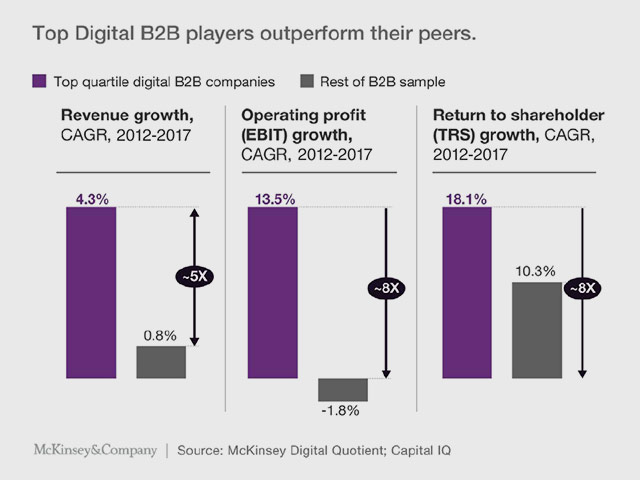
For many companies, social media in the past few years has been all about B2C brands, often in the luxury goods sector, using new generation-y bloggers and vloggers to promote themselves and their brands garnering millions of followers along the way. But in the past 5 yrs, B2B companies have begun to wake up to the opportunities they can achieve by using influencer marketing tools and approaches in a more refined and customised way that better suit their business development needs and industry environment. The rush of new agencies in the market dedicated to B2B IM and social media is a sign of the growth in activity and the testimonies from the likes of Cisco to Mendeley are showing clearly what can be achieved in driving business growth and in laying the platform for future success.
5. Optimising customer conversion online
Research from eConsultancy shows that an astonishing 72% of all customer shopper carts that initially get filled are subsequently abandoned and the sale is lost. That’s a very significant figure and eConsultancy wanted to find out why this is happening.
They found the following 5 key factors:
1. Checkout experience too long /required too many clicks
This is often about asking for too much detail, with some companies asking for eg date of birth, time at current address, marriage status, when that sort of data is immaterial. Frequently it’s about just too many pages to click through to get to the pay button, checkout page itself poorly designed with too much clutter and confusing calls to action, no PayPal functionality, no streamlined process for an existing customer, no simple “1-click” checkout.
And all these sort of items have been well-highlighted by numerous best practice pieces of research and yet still today the core lessons are not being learned and embraced.
With all the pressure on offline /bricks ‘n mortar retailing especially, surely even more imperative to get the online process as streamlined as possible.
2. Mobile check-outs performing especially poorly
In the eConsultancy research only 13% of online sellers scored well for the overall mobile customer experience. Companies that did score well included: Alaska Airlines (now merged with Virgin America), Argos, the multi-channel retailer awarded “top customer-focussed mobile app”, Fortnum & Mason who saw a 57% increase in mobile sales after they relaunched their mobile app making it easier to use, Booking.com, recognised as “the easiest to use search find book” travel app, ETQ Amsterdam shoes with focussed core selection for easier mobile search and Europcar who won the best mobile UX award for quick easy quote ‘n pay.
3. Customer service support is too often only 9-5
While some companies have moved to chat bots available 24/7, many customers still prefer personal /human interaction and customer service support. Such “traditional” service can work well but not if it’s only available 9 to 5. The research showed that 61% of companies did not offer the full day and night support even though some had clear data showing a substantial amount of online traffic in evenings and at weekends.
4. Delivery proposition is inadequate
Customer expectations are high in this area. Same day, or certainly next day delivery are assumed as standard, but still not offered by all online sellers. And sometimes when they are offered, the extra price is high relative to the items being purchased with few options to adjust and change.
5. Click and collect not available
Again, high expectations here but few deliver this seamlessly. Find online or on the mobile app, but frequently there is no click and collect option. Now with eg Collect Plus, Doddle, Hub Box, Amazon claiming a network in the UK alone of 13,000 locations, there is every easy opportunity for sellers without any store network to offer a competitively priced click collect option.
A very good example of integrated, easy to use, e-commerce that optimises the buyer experience and maximises “cart conversion” comes from Nike. Recognising just how multi-channel customers have become, their own in-store ‘Team Nike’ staff are known for being helpful, knowledgeable about the products and available. But it is also possible to shop entirely through the Nike app: scan QR codes to request items to be delivered to dedicated pick-up zones; ‘Ask The Expert’ for advice via the chatbot; kiosks have ‘hanger drop’ and bags; buy online using ‘shop the look’ on mannequins. It is possible to be outfitted without having spoken to a single associate, and this can be done in a store while looking at Nike product or anytime anywhere.
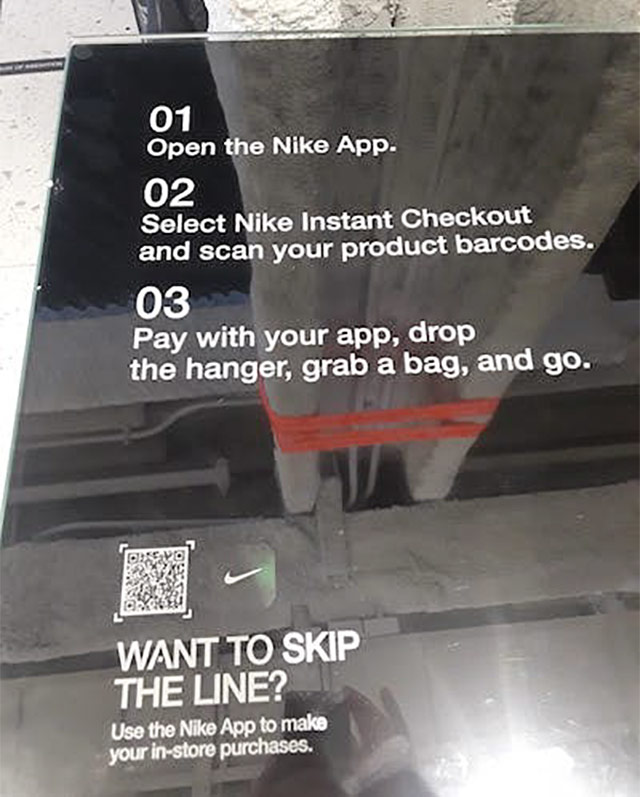
Article also available for download as a PDF
Related Articles
- Finding talent just got easier
- A new 2025 business model
- Quiet Quitting: 7 rules for managing it
- Building Out the Digital Team
- Digital and Data Transformation: 10 keys to success
- Leading B2B companies using digital to power sales & profit growth
- Employee engagement is the key to digital change and transformation
- What is the HR impact of digital on future talent needs and hiring?
- Evolution of the CDO role: 3 options for success
- Digital evolution of Marketing
- Winning in the talent wars
- Untapped potential of effective Customer Data & Analytics
© Michael de Kare-Silver 2023
Michael runs this specialist recruiting /headhunting practice Digital Prospects, helping companies recruit key talent where Digital and /or Data skills and savvy are important.
Michael used to be MD at Argos.co.uk and of Experian.com, he is ex McKinsey strategy consulting and Procter & Gamble marketing, Michael provides a personal and dedicated recruitment service that delivers results and is built on treating people with kindness and respect.